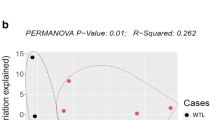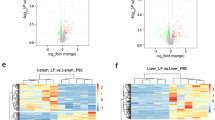Abstract
L-Tryptophan (Trp) was shown to improve the gut barrier and growth of weaning piglets. However, whether excessive dietary Trp regulates amino acids (AAs) metabolism and gut serotonin (5-HT) homeostasis in piglets with gut inflammation is not clear yet. We hypothesize that excessive dietary Trp alleviates acetate-induced colonic inflammation and gut barrier damage in weaning piglets partially through the regulation of colonic AAs metabolism and 5-HT signaling. Fifty-four 21-day-old weaned piglets were divided into six groups: control, acetate, 0.2%Trp, 0.2%Trp + acetate, 0.4% Trp, and 0.4%Trp + acetate. Piglets were fed a basal diet supplemented with 0%, 0.2%, or 0.4% of Trp throughout the 12-day experiment. During days 0–7, all piglets had free access to diet and drinking water. On day 8, piglets were intrarectal administered with 10 mL of 10% acetate saline solution or 0.9% saline. During days 8–12, all piglets were pair-fed the same amount of feed per kg bodyweight. Results showed that excessive dietary Trp alleviated acetate-induced reductions in daily weight gain and increase in feed/gain ratio. Trp restored (P < 0.05) acetate-induced increase in concentrations of free aspartate, glutamate/glutamine, glycine, 5-HT, and 3-methylindole in the colon, downregulation of zonula occludens-1 and 5-HT reuptake transporter (SERT) expression and upregulation of IL-1β, IL-8, TLR4, and 5-HT receptor 2A (HTR2A) expression, and the increase in ratios of p-STAT3/ STAT3 and p-p65/p65 in the colon. The above findings suggested that excessive dietary Trp in the proper amount regulated colonic AAs metabolism, 5-HT homeostasis, and signaling that may contribute as important regulators of gut inflammation during the weaning transition.


Similar content being viewed by others
Data availability
All data generated or analysed during this study are included in this published article and its supplementary file.
References
Bellono NW, Bayrer JR, Leitch DB, Castro J, Zhang CC, O’Donnell TA, Brierley SM, Ingraham HA, Julius D (2017) Enterochromaffin cells are gut chemosensors that couple to sensory neural pathways. Cell. https://doi.org/10.1016/j.cell.2017.05.034
Boudry G, Peron V, Le Huerou-Luron I, Lalles JP, Seve B (2004) Weaning induces both transient and long-lasting modifications of absorptive, secretory, and barrier properties of piglet intestine. J Nutr 134(9):2256–2262. https://doi.org/10.1093/jn/134.9.2256
Chalvon-Demersay T, Luise D, Le Floc’h N, Tesseraud S, Lambert W, Bosi P, Trevisi P, Beaumont M, Corrent E (2021) Functional amino acids in pigs and chickens: implication for gut health. Front Vet Sci 8:663727. https://doi.org/10.3389/fvets.2021.663727
Chen S, Wang M, Yin L, Ren W, Bin P, Xia Y, Liu G, Yang H, Tan B, Yin Y (2018) Effects of dietary tryptophan supplementation in the acetic acid-induced colitis mouse model. Food Funct 9(8):4143–4152. https://doi.org/10.1039/c8fo01025k
Dai Z, Sun S, Chen H, Liu M, Zhang L, Wu Z, Li J, Wu G (2019) Analysis of tryptophan and its metabolites by high-performance liquid chromatography. Methods Mol Biol 2030:131–142. https://doi.org/10.1007/978-1-4939-9639-1_11
Goudarzi R, Partoazar A, Mumtaz F, Yousefi-Manesh H, Abdollahi A, Dehpour A, Rashidian A (2020) Arthrocen, an avocado-soy unsaponifiable agent, improves acetic acid-induced colitis in rat by inhibition of NF-kB signaling pathway. J Food Biochem 44(7):e13244. https://doi.org/10.1111/jfbc.13244
Hou Y, Wang L, Yi D, Ding B, Chen X, Wang Q, Zhu H, Liu Y, Yin Y, Gong J, Wu G (2014) Dietary supplementation with tributyrin alleviates intestinal injury in piglets challenged with intrarectal administration of acetic acid. Br J Nutr 111(10):1748–1758. https://doi.org/10.1017/S0007114514000038
Jacobi SK, Odle J (2012) Nutritional factors influencing intestinal health of the neonate. Adv Nutr 3(5):687–696. https://doi.org/10.3945/an.112.002683
Kaser A, Lee AH, Franke A, Glickman JN, Zeissig S, Tilg H, Nieuwenhuis EES, Higgins DE, Schreiber S, Glimcher LH, Blumberg RS (2008) XBP1 links ER stress to intestinal inflammation and confers genetic risk for human inflammatory bowel disease. Cell 134(5):743–756. https://doi.org/10.1016/j.cell.2008.07.021
Kaur G, Krishan P (2020) Serotonin 5HT2A receptor antagonism mediated anti-inflammatory and anti-fibrotic effect in adriamycin-induced CKD in rats. Naunyn Schmiedebergs Arch Pharmacol 393(7):1269–1279. https://doi.org/10.1007/s00210-020-01826-0
Khan I, Al-Awadi FM (1997) Colonic muscle enhances the production of interleukin-1 beta messenger RNA in experimental colitis. Gut 40(3):307–312. https://doi.org/10.1136/gut.40.3.307
Kim CJ, Kovacs-Nolan JA, Yang C, Archbold T, Fan MZ, Mine Y (2010) l-Tryptophan exhibits therapeutic function in a porcine model of dextran sodium sulfate (DSS)-induced colitis. J Nutr Biochem 21(6):468–475. https://doi.org/10.1016/j.jnutbio.2009.01.019
Koopmans SJ, Ruis M, Dekker R, van Diepen H, Korte M, Mroz Z (2005) Surplus dietary tryptophan reduces plasma cortisol and noradrenaline concentrations and enhances recovery after social stress in pigs. Physiol Behav 85(4):469–478. https://doi.org/10.1016/j.physbeh.2005.05.010
Kwon WB, Soto JA, Stein HH (2022) Effects of dietary leucine and tryptophan on serotonin metabolism and growth performance of growing pigs. J Anim Sci. https://doi.org/10.1093/jas/skab356
Li P, Wu G (2022a) Functional molecules of intestinal mucosal products and peptones in animal nutrition and health. Adv Exp Med Biol 1354:263–277. https://doi.org/10.1007/978-3-030-85686-1_13
Li P, Wu G (2022b) Important roles of amino acids in immune responses. Br J Nutr 127(3):398–402. https://doi.org/10.1017/S0007114521004566
Liang HW, Dai ZL, Liu N, Ji Y, Chen JQ, Zhang YC, Yang Y, Li J, Wu ZL, Wu GY (2018) Dietary L-tryptophan modulates the structural and functional composition of the intestinal microbiome in weaned piglets. Front Microbiol. https://doi.org/10.3389/fmicb.2018.01736
Liu Y, Tian X, Daniel RC, Okeugo B, Armbrister SA, Luo M, Taylor CM, Wu G, Rhoads JM (2022) Impact of probiotic Limosilactobacillus reuteri DSM 17938 on amino acid metabolism in the healthy newborn mouse. Amino Acids. https://doi.org/10.1007/s00726-022-03165-1
Lv M, Yu B, Mao XB, Zheng P, He J, Chen DW (2012) Responses of growth performance and tryptophan metabolism to oxidative stress induced by diquat in weaned pigs. Animal 6(6):928–934. https://doi.org/10.1017/S1751731111002382
Moeser AJ, Vander Klok C, Ryan KA, Wooten JG, Little D, Cook VL, Blikslager AT (2007) Stress signaling pathways activated by weaning mediate intestinal dysfunction in the pig. Am J Physiol-Gastr L 292(1):G173–G181. https://doi.org/10.1152/ajpgi.00197.2006
Nugent SG, Kumar D, Rampton DS, Evans DF (2001) Intestinal luminal pH in inflammatory bowel disease: possible determinants and implications for therapy with aminosalicylates and other drugs. Gut 48(4):571–577. https://doi.org/10.1136/gut.48.4.571
Owaki T, Kamimura K, Ko M, Nagayama I, Nagoya T, Shibata O, Oda C, Morita S, Kimura A, Sato T, Setsu T, Sakamaki A, Kamimura H, Yokoo T, Terai S (2022) The liver-gut peripheral neural axis and nonalcoholic fatty liver disease pathologies via hepatic serotonin receptor 2A. Dis Model Mech. https://doi.org/10.1242/dmm.049612
Rezaei R, Gabriel AS, Wu G (2022) Dietary supplementation with monosodium glutamate enhances milk production by lactating sows and the growth of suckling piglets. Amino Acids 54(7):1055–1068. https://doi.org/10.1007/s00726-022-03147-3
Ruan Z, Yang Y, Wen Y, Zhou Y, Fu X, Ding S, Liu G, Yao K, Wu X, Deng Z, Wu G, Yin Y (2014) Metabolomic analysis of amino acid and fat metabolism in rats with L-tryptophan supplementation. Amino Acids 46(12):2681–2691. https://doi.org/10.1007/s00726-014-1823-y
Shen YB, Voilque G, Kim JD, Odle J, Kim SW (2012) Effects of increasing tryptophan intake on growth and physiological changes in nursery pigs. J Anim Sci 90(7):2264–2275. https://doi.org/10.2527/jas.2011-4203
Smith F, Clark JE, Overman BL, Tozel CC, Huang JH, Rivier JEF, Blisklager AT, Moeser AJ (2010) Early weaning stress impairs development of mucosal barrier function in the porcine intestine. Am J Physiol-Gastr L 298(3):G352–G363. https://doi.org/10.1152/ajpgi.00081.2009
Song ZH, Ke YL, Xiao K, Jiao LF, Hong QH, Hu CH (2015) Diosmectite-zinc oxide composite improves intestinal barrier restoration and modulates TGF-beta1, ERK1/2, and Akt in piglets after acetic acid challenge. J Anim Sci 93(4):1599–1607. https://doi.org/10.2527/jas.2014-8580
Spohn SN, Bianco F, Scott RB, Keenan CM, Linton AA, O’Neill CH, Bonora E, Dicay M, Lavoie B, Wilcox RL, MacNaughton WK, De Giorgio R, Sharkey KA, Mawe GM (2016) Protective actions of epithelial 5-hydroxytryptamine 4 receptors in normal and inflamed colon. Gastroenterology 151(5):933–944.e933. https://doi.org/10.1053/j.gastro.2016.07.032
Sun Y, Wu Z, Li W, Zhang C, Sun K, Ji Y, Wang B, Jiao N, He B, Wang W, Dai Z, Wu G (2015) Dietary L-leucine supplementation enhances intestinal development in suckling piglets. Amino Acids 47(8):1517–1525. https://doi.org/10.1007/s00726-015-1985-2
Velloso LA, Folli F, Saad MJ (2015) TLR4 at the crossroads of nutrients, gut microbiota, and metabolic inflammation. Endocr Rev 36(3):245–271. https://doi.org/10.1210/er.2014-1100
Wang J, Chen L, Li P, Li X, Zhou H, Wang F, Li D, Yin Y, Wu G (2008) Gene expression is altered in piglet small intestine by weaning and dietary glutamine supplementation. J Nutr 138(6):1025–1032. https://doi.org/10.1093/jn/138.6.1025
Wang Q, Hou Y, Yi D, Wang L, Ding B, Chen X, Long M, Liu Y, Wu G (2013) Protective effects of N-acetylcysteine on acetic acid-induced colitis in a porcine model. BMC Gastroenterol 13:133. https://doi.org/10.1186/1471-230X-13-133
Wang WW, Dai ZL, Wu ZL, Lin G, Jia SC, Hu SD, Dahanayaka S, Wu GY (2014) Glycine is a nutritionally essential amino acid for maximal growth of milk-fed young pigs. Amino Acids 46(8):2037–2045. https://doi.org/10.1007/s00726-014-1758-3
Wang B, Sun S, Liu M, Chen H, Liu N, Wu Z, Wu G, Dai Z (2020) Dietary L-tryptophan regulates colonic serotonin homeostasis in mice with dextran sodium sulfate-induced colitis. J Nutr 150(7):1966–1976. https://doi.org/10.1093/jn/nxaa129
Wang H, Li C, Peng M, Wang L, Zhao D, Wu T, Yi D, Hou Y, Wu G (2021) N-Acetylcysteine improves intestinal function and attenuates intestinal autophagy in piglets challenged with beta-conglycinin. Sci Rep 11(1):1261. https://doi.org/10.1038/s41598-021-80994-2
Wastyk HC, Fragiadakis GK, Perelman D, Dahan D, Merrill BD, Yu FB, Topf M, Gonzalez CG, Van Treuren W, Han S, Robinson JL, Elias JE, Sonnenburg ED, Gardner CD, Sonnenburg JL (2021) Gut-microbiota-targeted diets modulate human immune status. Cell 184(16):4137–4153.e4114. https://doi.org/10.1016/j.cell.2021.06.019
Wu GY (2013) Functional amino acids in nutrition and health. Amino Acids 45(3):407–411. https://doi.org/10.1007/s00726-013-1500-6
Wu G (2022) Nutrition and metabolism: foundations for animal growth, development, reproduction, and health. Adv Exp Med Biol 1354:1–24. https://doi.org/10.1007/978-3-030-85686-1_1
Wu G, Borbolla AG, Knabe DA (1994) The uptake of glutamine and release of arginine, citrulline and proline by the small intestine of developing pigs. J Nutr 124(12):2437–2444. https://doi.org/10.1093/jn/124.12.437
Wu G, Meier SA, Knabe DA (1996) Dietary glutamine supplementation prevents jejunal atrophy in weaned pigs. J Nutr 126(10):2578–2584. https://doi.org/10.1093/jn/126.10.2578
Xiao J, Shao L, Shen J, Jiang W, Feng Y, Zheng P, Liu F (2016) Effects of ketanserin on experimental colitis in mice and macrophage function. Int J Mol Med 37(3):659–668. https://doi.org/10.3892/ijmm.2016.2486
Yao K, Fang J, Yin YL, Feng ZM, Tang ZR, Wu G (2011) Tryptophan metabolism in animals: important roles in nutrition and health. Front Biosci (schol Ed) 3(1):286–297. https://doi.org/10.2741/s152
Acknowledgements
The authors would like to appreciate GW for constructive suggestions during the study and the anonymous reviewers for their helpful comments.
Funding
This work was supported by the National Natural Science Foundation of China (32072689, 31301979), the National Key R&D Program of China (2017YFD0500501), the National Key Basic Research Program of China (2013CB127303), and the 2115 Talent Development Program of China Agricultural University.
Author information
Authors and Affiliations
Contributions
BW, ZW, and ZD designed the experiment. BW and ZD wrote the manuscript. BW, LC, QS, ML, JK, SS, HC, YS, and ZD conducted the experiments and statistical analysis. ZD revised the manuscript and all authors have approved the final manuscript.
Corresponding author
Ethics declarations
Conflict of interest
The authors declare no conflict of interest.
Ethical approval
No human participants were involved in this study.
Informed consent
Not applicable.
Additional information
Handling editor: B. Yoo.
Publisher's Note
Springer Nature remains neutral with regard to jurisdictional claims in published maps and institutional affiliations.
Supplementary Information
Below is the link to the electronic supplementary material.
Rights and permissions
Springer Nature or its licensor (e.g. a society or other partner) holds exclusive rights to this article under a publishing agreement with the author(s) or other rightsholder(s); author self-archiving of the accepted manuscript version of this article is solely governed by the terms of such publishing agreement and applicable law.
About this article
Cite this article
Wang, B., Cui, L., Song, Q. et al. Excessive dietary L-tryptophan regulated amino acids metabolism and serotonin signaling in the colon of weaning piglets with acetate-induced gut inflammation. Amino Acids 55, 403–412 (2023). https://doi.org/10.1007/s00726-023-03239-8
Received:
Accepted:
Published:
Issue Date:
DOI: https://doi.org/10.1007/s00726-023-03239-8




